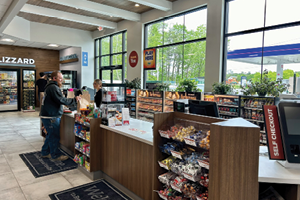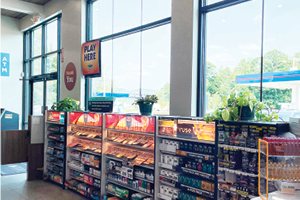If you walk into a Rusty Lantern store in New England, you’ll be met with an open, bright entrance thanks to the expansive, unobstructed windows overlooking the forecourt outside. Plants line the windowsills, giving the c-store a homey and comforting feel.
What you might notice is missing is the typical backbar that spans the full wall height behind the checkout counter.
The retailer, which has 28 stores in four states, opted for a low-profile tobacco section under the windows that’s not much taller than counter height. It worked with a local millwork provider to design custom fixtures and wooden shelves that help elevate the overall look of the store and make the register more inviting.
“You don’t usually see plants on displays in other convenience stores,” said Keri Weekley, category manager at the food-focused c-store that’s a local hit for its fresh lobster rolls. “But we’re not your typical convenience store. And we want you to walk in and immediately see that.”
Like all retailers, Rusty Lantern’s category managers are grappling with the rapidly changing tobacco inventory as consumer preferences evolve and new products hit the market.

“The product mix is changing so much more frequently than it ever has. There is always something new coming out because the cigarette category is declining, so [suppliers] have to try to make up those dollars. It’s crazy how fast it’s changing,” said Weekley.
If you walk into a Rusty Lantern store in New England, you’ll be met with an open, bright entrance thanks to the expansive, unobstructed windows overlooking the forecourt outside. Plants line the windowsills, giving the c-store a homey and comforting feel.
The Tobacco Assortment Evolves
The fastest growing segment of the category, said Shelly Blanchette, category manager for cigarettes and tobacco at Rusty Lantern, is vapor, followed by new modern oral products. “Cigarettes account for about 72% of our assortment, e-cigarettes are about 11%, new modern oral is almost 7%, and those are followed by smokeless at 5% and cigars at 3%. But oral products keep growing to the point that some manufacturers can’t keep up with the demand for supply.”
Smokeless products represented 37.0% of other tobacco category sales according to the NACS State of the Industry Report® of 2023 Data—the largest Other Tobacco Product (OTP) subcategory. The second-largest sales contributor to the category was e-cigarettes at 28.1% of sales, and in addition to cigars at No. 3, the only other subcategory to account for over 10% of category sales was the catch-all category “other tobacco,” which includes products like modern oral tobacco. The subcategory grew from 8.0% of category sales in 2022 to 12.3% in 2023. Overall, smokeless, e-cigarettes, cigars and other tobacco accounted for 91.3% of OTP category sales.
When consumers transition to alternative nicotine products, “vapor is what most adult smokers turn to first,” said a spokesperson from Reynolds American Inc. “Vapor is the fastest growing category in the smoke-free nicotine space.”
Vapor is the fastest growing category in the smoke-free nicotine space.”
Reynolds and many other major tobacco manufacturers are transitioning to more smokeless options and are putting more spend behind developing “potentially less risky” alternatives to combustibles. In July, Reynolds launched a nicotine-free vape product. The Sensa line comes in six fruit-infused flavors and follows the company’s ethos for tobacco harm reduction. Globally, Reynolds aims to “have 50 million adult consumers migrate to non-combustible products by 2030. The industry has an opportunity to offer adult smokers who do not wish to quit tobacco products altogether evidence-based, innovative choices that are potentially less risky than traditional combustible cigarettes,” the Reynolds spokesperson told NACS Magazine.
Altria, which has also committed to growing its smoke-free product category, said that smokers “have transitioned to smoke-free products at an accelerated pace. Of the 52 million tobacco consumers, we estimate that nearly 30% exclusively use smoke-free formats.”
Altria is focusing heavily on its recently acquired NJOY brand and e-vapor business. NJOY ACE is currently the only pod-based e-vapor product with market authorization from the FDA, said the company.
And Black Buffalo offers a unique alternative to chewing tobacco—minus the tobacco. The company’s nicotine pouches and dip products are made with tobacco alternatives, and it also carries nicotine-free variations of both products. “Our non-nicotine versions are booming, which I never expected. They’re the number one seller right now,” said Matthew Hanson, chief growth officer at Black Buffalo.
More Emphasis on Merchandising
With a sea of products to choose from and limited space due to its fixture design, Rusty Lantern has no room to stock items that won’t sell. “You can’t grow a fixture,” Blanchette joked.
“Everybody is vying for space [in the backbar], and we have to make sure we have space for all of the items that are growing, while still keeping true to the rest of the category and servicing our consumer needs,” she explained. “It’s a really creative process to fine tune the planograms and sometimes it comes down to two facings—just two or three little spots that can make or break some categories.”
Sometimes, that means getting rid of items that are “slow movers” or only appeal to niche customers. “Even with all the new stuff coming in, no one wants to take out the old stuff. But we are loyal to the register,” said Weekley. “And we know our sales data, so manufacturers work within our confines because they see that what we’re doing is working. The rate of return is phenomenal.”

Though product placements are often specified through contracts and trade agreements, Reynolds said that retailers who are dedicating “highly visible” space to new smokeless products and showcasing them in the backbar “are growing in the smoke-free space at a faster pace than their counterparts.”
Hanson agreed, adding that “A couple years ago, you would have seen all these products intermingled and it used to feel like anything goes in the backbar,” he said. “Now, you’re seeing very defined sections for cigarettes, smokeless, new modern oral products and vapes so customers know where to look. And the merchandising has stepped up in a big way, with well lit, very clearly defined and maintained spaces for the next generation of nicotine products.”
Compliance Complications
Keeping up with the latest product innovations also means retailers need to stay vigilant about compliance as illicit products flood the market. At the time of publication, the FDA has only approved 34 e-cigarette products out of millions of applications, and much uncertainty remains as to what retailers can and cannot sell.
“There are still many products that the FDA hasn’t made determinations on, and they’ve granted some exceptions to products they’ve denied. This has created mass confusion within the industry of which products can be on shelves and which can’t,” said Anna Ready Blom, director of government relations at NACS. “NACS has continually asked FDA for clarity, but they have refused, which is why we are now looking at federal legislation to help.”
Ready Blom added that the lack of clarity about which products are legal has “opened a loophole” for illicit products to flood the market.
Now, you’re seeing very defined sections for cigarettes, smokeless, new modern oral products and vapes so customers know where to look.”
“It’s a very challenging time to be a category manager of the backbar because it’s a dramatically changing landscape and also fraught with regulatory control,” added Hanson. “People don’t know what is or isn’t approved, what’s gotten denied, what’s gotten a marketing order granted or if something is just in limbo in the courts. So do you stock up on a product or not considering you might buy something that gets denied, and then what do you do with it?”
Lonnie McQuirter, who owns 36 Lyn Refuel Station in Minneapolis, takes a conservative approach in the strictly regulated city. “We’ve made the decision not to really be first in the space when it comes to stocking products on the tobacco side. We err on the side of caution, because there are a lot of products where we’re not entirely sure of the legality, and I’m not willing to take the chance of harm coming to the consumer for some reason. It’s better for me to take a conservative approach,” he explained.
In today’s current market rife with illicit products, “compliance will rule the day,” said Hanson. “That’s responsible marketing from the manufacturing side as well as responsible age verification at the retail side. At Black Buffalo, we live and die by compliance, and we have earned the right to exist by getting approved by the FDA. The brands that do that have seen a positive reception from retailers who know they’re dealing with a company that’s built for the long haul and isn’t just a fast money mover trying to make a quick buck off an illegal vape.”
For Rusty Lantern, which operates stores in multiple municipalities and states, the local piecemeal approach to regulations and approved products—which vary by town, can often be inconsistent and are updated without warning—presents a different host of compliance challenges.
On a state-wide level, updating pricing information or inventory in the retailer’s system is easy, but when local cities and towns change a rule it’s tough to individually track and manage, Weekley and Blanchette said. Take menthol and flavor bans for example, which in New England are regularly enacted on a town-by-town basis. There is of course the state-wide Massachusetts ban, but Rusty Lantern’s category managers said there are six cities in Maine that have individual flavor bans and more towns are likely to follow suit.
We err on the side of caution, because there are a lot of products where we’re not entirely sure of the legality”
Plus, the local councils often don’t announce or update retailers on new changes, adding another layer of complication.
“We obviously want to be compliant and are trying to be at every step and with every law. But it can be a daunting task, and the towns are not proactive about letting us know when things change,” said Weekley. “Sometimes we hear something secondhand and have to scramble to adhere. Overall it’s hard to wrangle because tobacco regulations are ever-evolving.”
Retailers should make a concerted effort to “stay in front of policymakers and remind them that we’re their partner,” said McQuirter. “The convenience industry has the longest track record of selling age-restricted products in the U.S., and we are the best outlets for these types of products. We’ve been doing this for longer than any other industry. There are bad actors out there just like anywhere, but we are very much the good guys when it comes to compliance.”
Notes from Lessons Learned
Retailers in any state can learn a lesson from the regulatory challenges that retailers like Lonnie McQuirter, owner of 36 Lyn Refuel Station in Minneapolis, and Rusty Lantern have to navigate.
“People should really think about what their business model will look like if [these restrictions] happen on a federal level,” said McQuirter. “It wouldn’t hurt to look at places like Minneapolis, San Francisco and Massachusetts to see what a potential future might look like. I’d encourage retailers that operate in more hands-off states, where they’re allowed to sell many products, to see how other retailers are getting by.”
He added that he wouldn’t have been able to pivot his business strategies and adapt to new regulations so well if he hadn’t networked with European retailers that went through similar changes years before. “It opened my eyes to see some of that happening in real time. And while the challenges others face are different, there is always something to take away and learn from.”